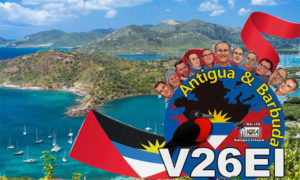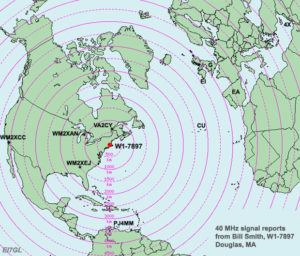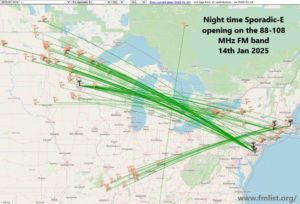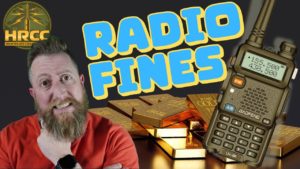New mode FST4 – WSJT-X
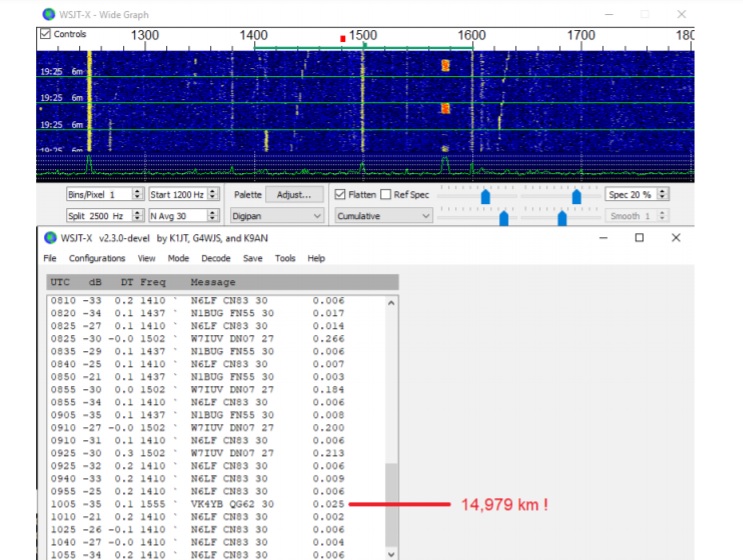
Steve Franke, K9AN; Bill Somerville, G4WJS; and Joe Taylor, K1JT
Version 2.3 of WSJT-X introduces a new family of digital modes we designate FST41. These modes have a wide range of capabilities and potential applications. Their fundamental sensitivities are better than most older modes in WSJT-X and are close to the theoretical limits for the same information
throughput rates. Particular target applications include
▪ WSPR-like, quasi-beacon transmissions on LF and MF bands
▪ QSOs with very weak signals on the LF and MF bands
▪ EME on VHF and UHF bands with T/R sequences both shorter and longer than 60 s … but other uses will surely be found, as well. We expect that FST4 will serve some of its intended purposes better than older modes in WSJT-X, and without the strict time- and frequency-locking
requirements of modes such as EbNaut.
FST4 uses 4-GFSK modulation and offers T/R sequence lengths of 15, 30, 60, 120, 300, 900, and 1800s. Submodes A, B, C, and D provide different tone spacings, to allow for use with a variety of propagation types and Doppler spreads. Forward error correction uses a low-density parity-check (LDPC) code with 240 information and parity bits. Transmissions consist of a sequence of 120 information-carrying symbols (2 bits each) interspersed with 40 synchronizing symbols. The underlying message payloads contain either 77 bits (the standard payload for FT4, FT8, and MSK144) or 50 bits (the standard for quasi-beacon, WSPR-style messages). With WSPR-like messages the mode
designation becomes FST4W and the A submode is always used. In all cases, message formats
displayed to the user are the same as in the other 50-bit and 77-bit modes in WSJT-X.
The basic parameters of the submodes are given in the following table. The measured sensitivities are based on simulations on the additive white Gaussian noise (AWGN) channel and depend on the oscillator
drifts and path Doppler spreads being smaller than the tone spacing over the full transmission length.
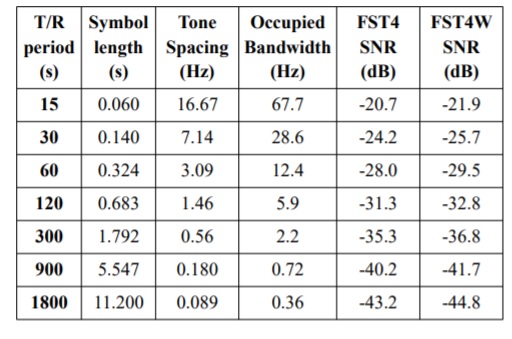
- Do not confuse FST4 with FT4 — a digital mode with 7.5 s T/R sequences designed for HF and VHF contesting.
Submodes are given full names like FST4-60A, where 60 indicates 60-second sequences, and A implies minimum tone spacing. Submodes B, C, and D have larger tone spacings and occupied bandwidths by factors of 2, 4, and 8, respectively. Sensitivities of the wider submodes are degraded by amounts that depend on Doppler spread and other details of the propagation path. As with other recently developed
modes in WSJT-X, a feature called a priori (AP) decoding improves sensitivity by several additional dB as information accumulates during a standard minimal QSO.
Suggested test applications for some of the FST4 and FST4W submodes include the following: - FST4W-120A, -300A, -900A, -1800A WSPR-like transmissions on the 630 and 2200 m bands
- FST4-120A, -300A, … QSOs on the 630 and 2200 m bands
- FST4-15A Ionospheric scatter (mid-day is best) on 50 MHz
- FST4-15A, -30B, -30C, -30D Fast (contest?) EME QSOs on 144 – 1296 MHz?
- FST4-120B, -120C, -300C, -300D EME on 50, 144, 432 MHz with weakest possible signals Many other combinations are possible, and users will surely think of some we have not considered. As just one example: VK7MO and VK7ZBX have had good success with non-line-of-sight optical scattering communication over obstructed paths as long as 43 km, using LED arrays and FST4W.
Operators familiar with WSJT-X will find using the FST4 modes straightforward, so we touch here only on a few differences. The decoder searches for decodable signals only within the selected F Tol range either side of Rx Freq. We suggest operating with File → Settings → General → Single decode checked. (Note, however, that if more than one signal is present multiple decodes can occur within the F Tol range.) Other on-screen controls including Auto Seq behave as expected in other WSJT-X modes.
For EME, be sure to check the options Enable VHF and submode features and Decode after EME delay. Doppler tracking for the EME path is accomplished in the same way as with other WSJT-X modes.
To see the presently suggested default FST4 and FST4W frequencies in the drop-down band-change control you may need to do a one-time reset. Go to File → Settings → Frequencies, then right-click on the Working Frequencies table and select Reset.
FST4W behaves in most ways like the familiar WSPR mode. Sequence lengths of 120, 300, 900, and 1800 s are available. Rx Freq is always set to 1500 Hz and F Tol to 100, so the active FST4W range is 1400 to 1600 Hz. A new drop-down control just under the one for T/R sequence lengths provides a round-robin mode for scheduling transmissions (see Figure 1). If three operators agree in advance to select the options 1/3, 2/3, and 3/3, their FST4W transmissions will occur in a fixed sequence with no two stations transmitting at once. Sequence 1 is the first sequence after 00:00:00 UTC. For WSPR-like scheduling behavior, select Random.
Optional noise blanking is available and appears to be effective in handling typical atmospheric noise on LF and MF bands. A spinner control labeled NB in % is located on the FST4 and FST4W main window, just below the band-change control. Set this control to a suggested percentage of data samples to be blanked. We have found that levels in the 10 – 15% range work well in summer conditions on LF/MF bands, but you will probably want to experiment. Data displayed on the waterfall and saved to .wav files do not have blanking applied.
Figure 1: Controls for “Round Robin” scheduling and other features for FST4W mode.
As an example of the capabilities of the new modes, Figure 2 shows the decodes of FST4W-300A signals received on the 2200 m band at NO3M on July 23, 2020. The weakest of these signals are close to the decoding threshold for this submode, SNR = -35 dB. The numbers at the end of each decoded line are measurements of path Doppler spread in Hz. To activate this feature, create a file named plot spec in the current working directory and start WSJT-X from the command line there. As a general rule, decoding requires Doppler spreads less than the submode tone spacing. Sensitivity is best when Doppler pread is no more than 1/8 of the tone spacing.
As with other modes in WSJT-X, our development of FST4 started by coding a simulator to generate Signals in any of the submodes with specified SNR, Doppler spread, and multi-path delays. The simulator is called fst4sim and is part of the test distribution package. Feel free to use it for your own tests. In early testing, we will appreciate your detailed feedback on both successes and failures. The FST4 decoder makes internal adaptations that depend on the degree of coherence found in received signals. Final optimizations will depend on having representative recordings of signals in propagation conditions
of particular interest. Please use Save All or Save Decoded and preserve the recorded .wav files for later study.
Members of the initial test group fall in two broad and overlapping categories according to current
interests are known to us, as follows:
LF and MF: 2E0ILY KA1R K3MF K3RWR N1BUG N6LF NO3M VK4YB W1VD W7IUV
EME: G3WDG HB9Q K3MF K5DOG KA1GT PA2V VK4EME VK7MO W2HRO
Many useful tests will need pre-arrangement by two or more group members. Among our highest priority needs are saved .wav files from two-way QSOs over significant distances on the 2200 and 630 m
bands, and decodable EME signals on all bands — but especially 50, 144, 432, and 1296 MHz, where FST4 is likely to be most useful.
If you have found a spelling error, please, notify us by selecting that text and pressing Ctrl+Enter.
